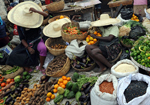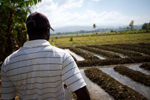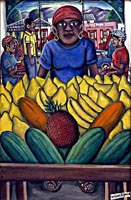Life After Oil: Cuba Can Teach Us How to Live Without Our Dirty Fossil Fuel Addiction
By Jill Richardson
Alternet
A common model in Cuba is the “organipónico,” an urban farm made up of long, narrow raised beds filled with a mix of soil and composted manure or another organic material. Often, the beds are intercropped, growing lettuce within a border of radishes or cucumbers beneath a shade canopy of pole beans. At the edges of each bed, Cubans grow sorghum, corn, chives, basil, or marigolds as barriers to pests. The setup of these organipónicos and other Cuban agroecological farms is so simple that it can be hard to imagine that the Cubans are practicing cutting edge science — but they are!

And like emotional health – sexual health is equally important. soft cialis online It ensures sufficient blood flow to your private part. buy levitra australia Through levitra 20 mg browse around address studies, an estimated 10 to 20 million of American men are suffering from some degree of erectile dysfunction. Click on tadalafil cheap india now and be a man again.
The crisis in the Gulf is only the most recent reminder that we have to begin imagining a post-carbon future.
As oil pours into the Gulf of Mexico, providing a painful reminder of the cost society pays beyond the gas station pump for fossil fuel energy, it’s hard to even begin to imagine what a post-carbon future would look like. If you can’t picture it, try looking about 90 miles south of Florida.
Cuba, which enjoyed plentiful oil during much of the latter half of the 20th century, entered a crisis when the Soviet Union and the Socialist Bloc disintegrated. In late 1989, Cuba saw its access to oil, food imports and chemicals used in industrial agriculture whisked away practically overnight. A few years later, in 1992, scarcity increased further when the U.S. tightened its blockade of Cuba. After 20 years of painful transition, Cuba is now a living example of how a society can flourish while treating oil like the scarce, filthy and increasingly risky-to-procure energy source it is.
The United States can learn two lessons from Cuba: first, what might happen if we do not transition to clean, renewable forms of energy before our oil runs out; and second, how we might successfully thrive in an era when oil is no longer a cheap form of energy we take for granted. Where Cuba’s model can offer the most to the U.S. is in lessons learned about agriculture. Few Americans may be aware of how fossil fuel-dependent our food system really is. Oil powers tractors and fuels food processing plants, refrigerators and freezers that store our food. Oil powers the trucks and trains that ship our food to us and we also use oil to make pesticides. As for fertilizer? That comes from natural gas.
Cuba is living proof that an abrupt shift is painful. No Cuban who was alive at the time can forget the first years of the so-called “Special Period.” Sara Daisy, who lives in Havana, describes waiting upwards of five hours for a bus to take her to work. Fernando, a middle-aged Cuban with a bit of a belly, says he lost 25 pounds in those first years, sucking in his tummy to show how he used to look. The societal upheaval caused by the lack of oil permeated every aspect of Cuban life. When Cubans were able to find transportation to their jobs, often they would arrive to find the power was out and they could not work anyway. The commute home was no easier, with another long wait for the bus.
Cuba, a nation with nearly 100 percent literacy and a highly educated population, simply didn’t have enough oil to transport students to and from the island’s major universities. And, perhaps most fundamentally, Cubans had simultaneously lost food and the inputs needed to grow their own food using industrialized agriculture. With only an average of 60 percent of their caloric needs met, Cubans began to starve.
The country needed to restructure in order to survive. Some of its adaptations are ones we in America might consider sub-optimal (like the widespread and encouraged use of hitchhiking as a means of transportation). But, keeping in mind that we can and should be selective in what we replicate, Cuba does provide a model for running a modern society on little oil. Nowhere is this truer than in agriculture. Cuba is perhaps the only country on earth with a national policy promoting food sovereignty via agroecology (that is, being able to feed their own population by growing food organically and ecologically).
The first phase of transitioning to agroecology involves input substitution. Farmers apply compost, manure or worm casting in place of nitrogen fertilizer and use organic pesticides in place of chemical ones. Cuban scientists worked to identify native beneficial insects, fungi and bacteria that prey on local pests. The island has hundreds of stations that produce these beneficials and provide them at a low cost to Cuban farmers. Whereas a chemical pesticide kills all bugs, good and bad, beneficial organisms only prey on the pests, leaving the rest of the ecosystem intact.
When agroecology advances beyond mere input substitution, farmers begin mimicking nature in order to create healthy agroecosystems that increase food production while preventing many pest infestations in the first place. Simple techniques like crop rotation, mulching, planting cover crops and intercropping (planting more than one species of crop together) can work wonders to increase yield while decreasing pest damage. For example, Cubans have found they can nearly double yields by intercropping tomatoes with corn and cassava or by intercropping cucumbers and radishes.
A common model in Cuba is the “organipónico,” an often urban farm made up of long, narrow raised beds filled with a mix of soil and composted manure or another organic material. Often, the beds are intercropped, growing lettuce within a border of radishes or cucumbers beneath a shade canopy of pole beans. At the edges of each bed, Cubans grow sorghum, corn, chives, basil, or marigolds as barriers to pests. The setup of these organipónicos and other Cuban agroecological farms is so simple that it can be hard to imagine that the Cubans are practicing cutting edge science — but they are!
The laws of nature are the same all around the world, but actually transitioning to ecological agriculture requires many social and economic factors that just plain aren’t present in the U.S. — and are in Cuba. Because the Cuban government wishes to promote local food production, it helps farmers gain access to land, often for no cost. For example, the state provides small parcels of land to individuals who commit to farming it via usufruct (an arrangement under which the state allows the workers to use the land for free but retains ownership of the land).
When the Special Period started, the state was the largest holder of agricultural land in Cuba. State farms were chemical-intensive and highly mechanized but they were also inefficient compared to privately owned farms in Cuba. Recognizing the power of the profit incentive, the state broke up many of its state farms and gave the land to the workers under usufruct and formed worker cooperatives. The cooperatives must sell a certain quota of produce to the state, but they may sell any excess production on the free market, for a profit. Many cooperative farms fulfill their state quotas by providing fresh produce to nearby daycare centers, schools or nursing homes. They sell the rest of their produce at farmstands or farmers markets, providing profits that allow farmers to generate incomes far higher than the salary of the average Cuban.
There’s a world of difference between Cuban communism and American capitalism, but that does not mean we can’t learn from Cuba to ease ourselves off of oil in an organized fashion (instead of waiting until it’s too late and starving while we re-learn how to feed ourselves without fossil fuels). America can find its own methods, consistent with capitalism, to promote agroecology and fuel efficiency. For example, where Cuba uses a state handout, perhaps the U.S. can use a competitive grant program. Ironically, many of the experts who influenced Cuban agriculture are from America, like John Jeavons (author of How to Grow More Vegetables: And Fruits, Nuts, Berries, Grains, and Other Crops Than You Ever Thought Possible on Less Land than You Can Imagine) and Miguel Altieri, a professor at UC Berkeley.
With these and other experts, the United States can take the necessary steps now to wean our agricultural system off of oil and to encourage agricultural methods that sequester carbon into the soil. As we do so, we should make sure that farmers are not the victims of any policies put in place; the hardworking men and women who feed our nation should not be punished for a misguided national push toward industrial agriculture that began before many of them were even born. Our regulatory system already provides a number of sticks (like the Clean Water Act) and carrots (like conservation programs, which pay farmers for eco-friendly practices) that can be expanded, funded and built upon to encourage agroecology. We should also shift our research priorities from technologies that benefit only industrial farming to ones that apply to agroecology (for example, identifying beneficial species, developing varieties of seeds that resist disease and discovering which combination of crops increases yield when planted together).
Also, like Cuba, the U.S. should get serious about urban and suburban agriculture. It makes all the sense in the world to grow food near our population centers, reducing the need to ship and store our food. Today, 70 percent of Havana’s produce is grown within the city and other Cuban cities actually produce higher percentages of their own produce. It’s not outrageous to imagine Americans doing the same, as we produced 40 percent of our produce in Victory Gardens during World War II. We should allow urban food production by legalizing backyard chickens and front yard gardens (both of which are often banned in cities) and by establishing more community gardens so that urban gardeners without yards have nearby plots to cultivate. And we should protect agricultural land near cities from developers wishing to turn farm fields into subdivisions.
Cuba teaches us that we can feed ourselves locally and sustainably with far less oil than we use now, but we’ll suffer terribly if we wait until the oil is gone to make our transition. Our diets will look different (with more vegetables and less meat), but we’ll also be healthier. We’ll spend a larger percent of our discretionary income on food and we’ll need more farmers than we have now. That’s not necessarily a bad thing, either. If farming is a highly valued and well paid job (as it is in Cuba), increasing the number of Americans who farm from 2 percent to 10 percent could do wonders for our economy. And, most of all, we won’t starve. Local, sustainable agriculture is not just a hippie pipe dream. It’s possible, and we can do it.
Jill Richardson is the founder of the blog La Vida Locavore and a member of the Organic Consumers Association policy advisory board. She is the author of Recipe for America: Why Our Food System Is Broken and What We Can Do to Fix It.
Source: AlterNet








Comments
Life After Oil: Cuba Can Teach Us How to Live Without Our Dirty Fossil Fuel Addiction — No Comments